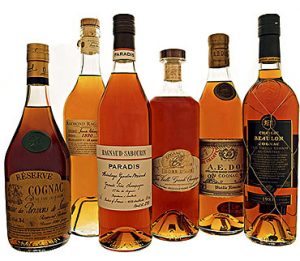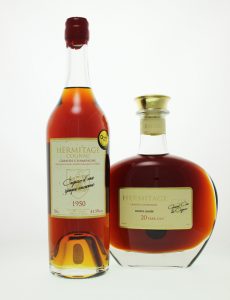Cognac Classifications on Bottle Labels
 There are all manner of cognac classifications found on bottle labels, but what do they actually mean? Most of the generic terms below describe cognacs made by blending hundreds, or even thousands, of cognacs together to produce a vast quantity of a homogenous product for sale on supermarket shelves. As demand increases younger and younger cognacs are used in these blends so sugar syrup and caramel colouring are added to obscure the fieriness on the tongue and lack of appealing colour.
There are all manner of cognac classifications found on bottle labels, but what do they actually mean? Most of the generic terms below describe cognacs made by blending hundreds, or even thousands, of cognacs together to produce a vast quantity of a homogenous product for sale on supermarket shelves. As demand increases younger and younger cognacs are used in these blends so sugar syrup and caramel colouring are added to obscure the fieriness on the tongue and lack of appealing colour.
VS stands for Very Special. Also known as *** (3-star) or Premium, the youngest eau-de-vie in the blend must be at least 2 years old. Many of these younger cognacs are purchased by the ‘Big Four’ companies in order to meet their ever-growing demand.
VSOP stands for Very Superior Old Pale. The youngest eau-de-vie in the blend must be at least 4 years old. The colour of cognac deepens the longer it stays in contact with the wooden barrel. Although described as ‘Pale’ these young cognacs can also have caramel added which provides a red glow.
Napoleon. Named after the very famous Frenchman, Napoleon Boneparte, the youngest eau-de-vie in the blend must be at least 6 years old. Up until April 2018, this was also the age of XO.
XO stands for Extra Old and must be aged for a minimum of 10 years. Although not official terms, Extra and Hors d’Age are often used to describe cognac of XO quality and age. Some small producers sell XO that maybe up to 20 years old but, it is unlikely that this will be specified on the label.
XXO is a new classification that stands for Extra, Extra Old and the youngest eaux-de-vie in any blend must have been aged for a minimum of 14 years.
Other terms such as Reserve, Très Vieille and Heritage are often used to describe blends that are much older than XXO although none are official nomenclature. They could be 15 or 50 years old.
So you can see that it is very difficult to decipher exactly what is in your bottle of cognac with a generic label as only minimum ages are specified and they are highly blended. Sometimes Single Estate is used to describe a cognac where all the eau de vie used has come from the same estate. In this case, far fewer cognacs will be used to make the blend so the flavour should be more individual.
 Cognacs with Age Statements (eg 30 Year Old) are more precise as they list the youngest eau de vie used and may also comprise a blend of just one or two cognacs or indeed be Single Cask (unblended). Vintage Cognacs also give you specific information. The year on the label describes the year the grapes were harvested. The cognac will be aged to perfection before being taken out of the wood and placed in glass when it will no longer mature. Most vintage cognacs will tell you when the cognac was bottled and therefore, for how long it was aged. This is the category that has the most information available to you, the customer. They are expensive to produce as the casks are strictly controlled throughout the decades of ageing. However, you can be sure that you are drinking cognac that has been matured to its optimum level, is unblended and has an unbelievable variation of aromas and flavours. We call this complexity.
Cognacs with Age Statements (eg 30 Year Old) are more precise as they list the youngest eau de vie used and may also comprise a blend of just one or two cognacs or indeed be Single Cask (unblended). Vintage Cognacs also give you specific information. The year on the label describes the year the grapes were harvested. The cognac will be aged to perfection before being taken out of the wood and placed in glass when it will no longer mature. Most vintage cognacs will tell you when the cognac was bottled and therefore, for how long it was aged. This is the category that has the most information available to you, the customer. They are expensive to produce as the casks are strictly controlled throughout the decades of ageing. However, you can be sure that you are drinking cognac that has been matured to its optimum level, is unblended and has an unbelievable variation of aromas and flavours. We call this complexity.
